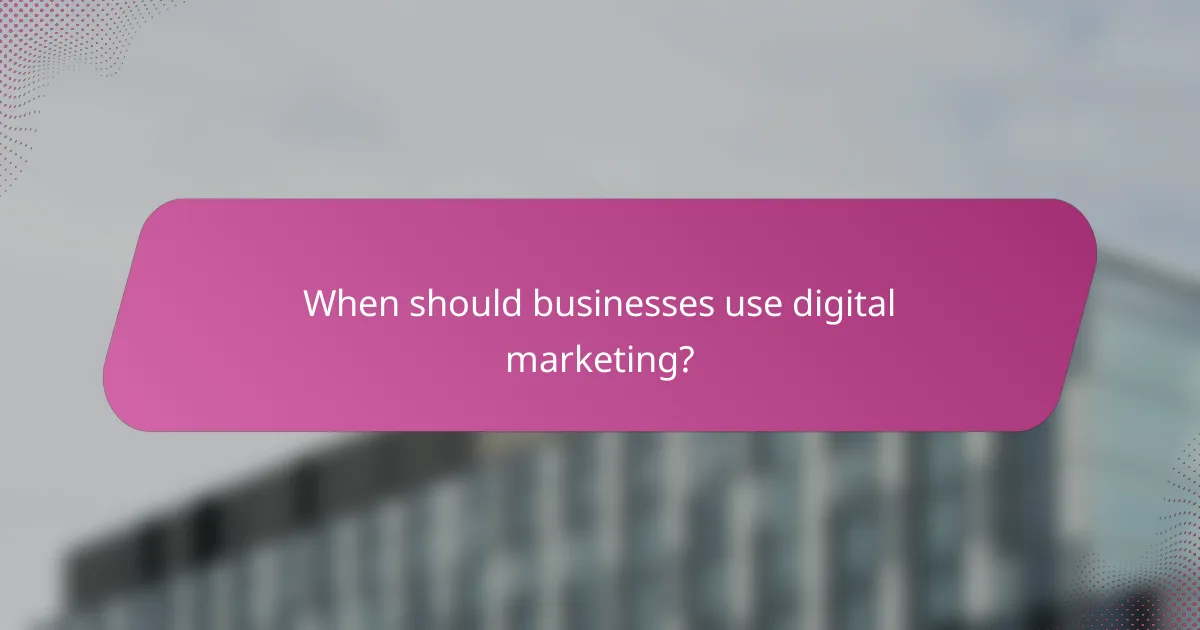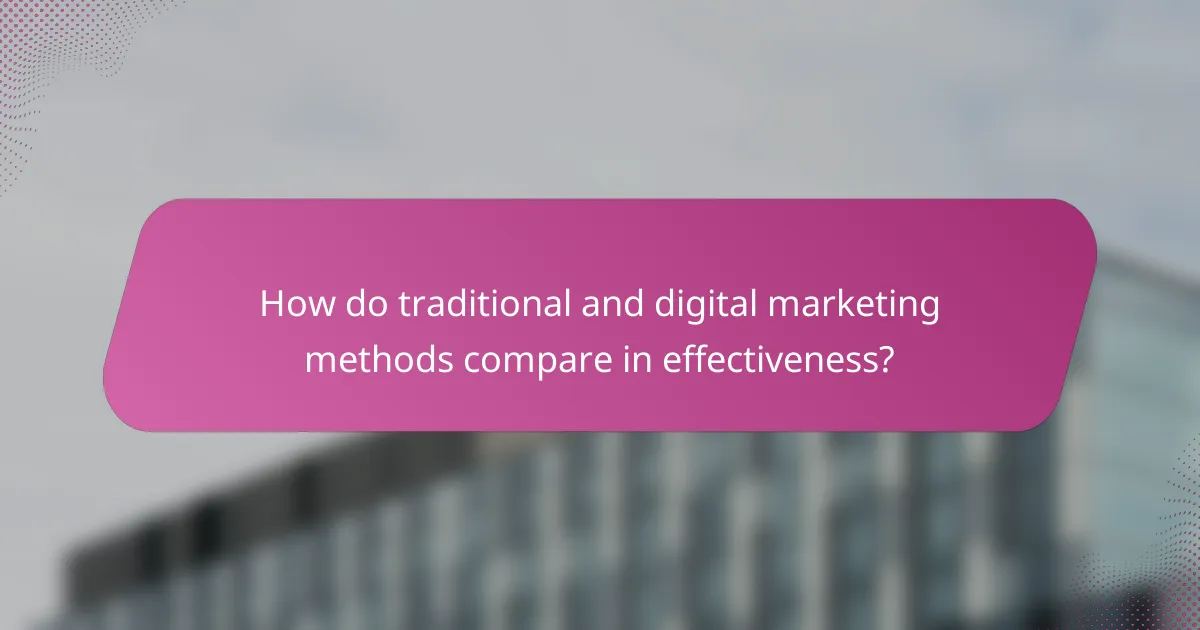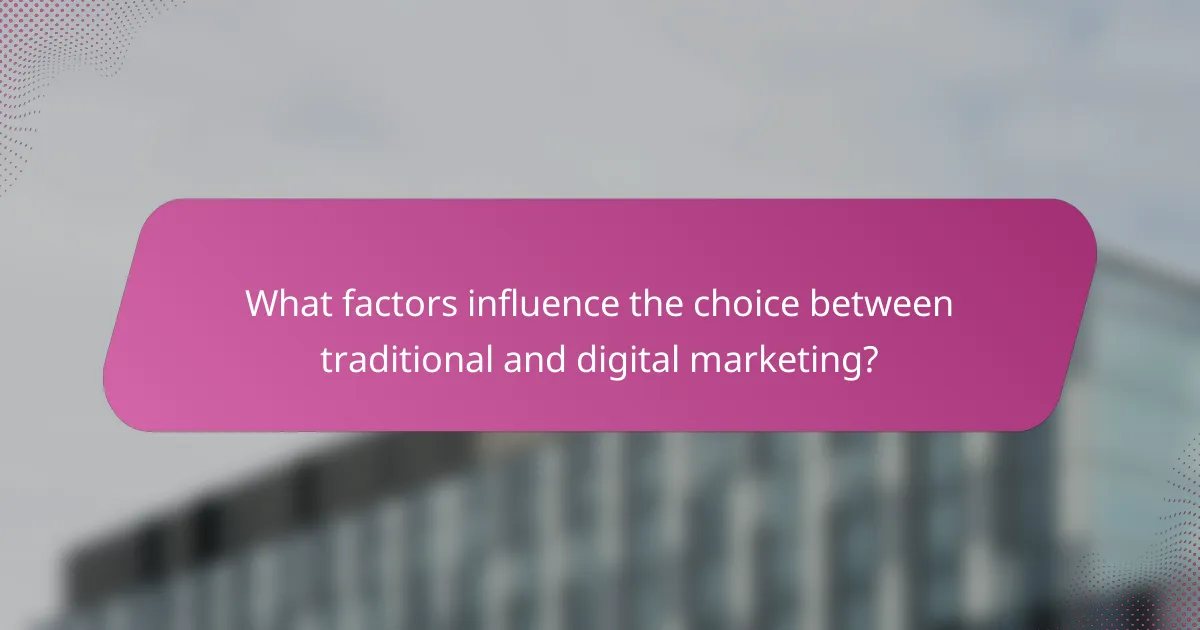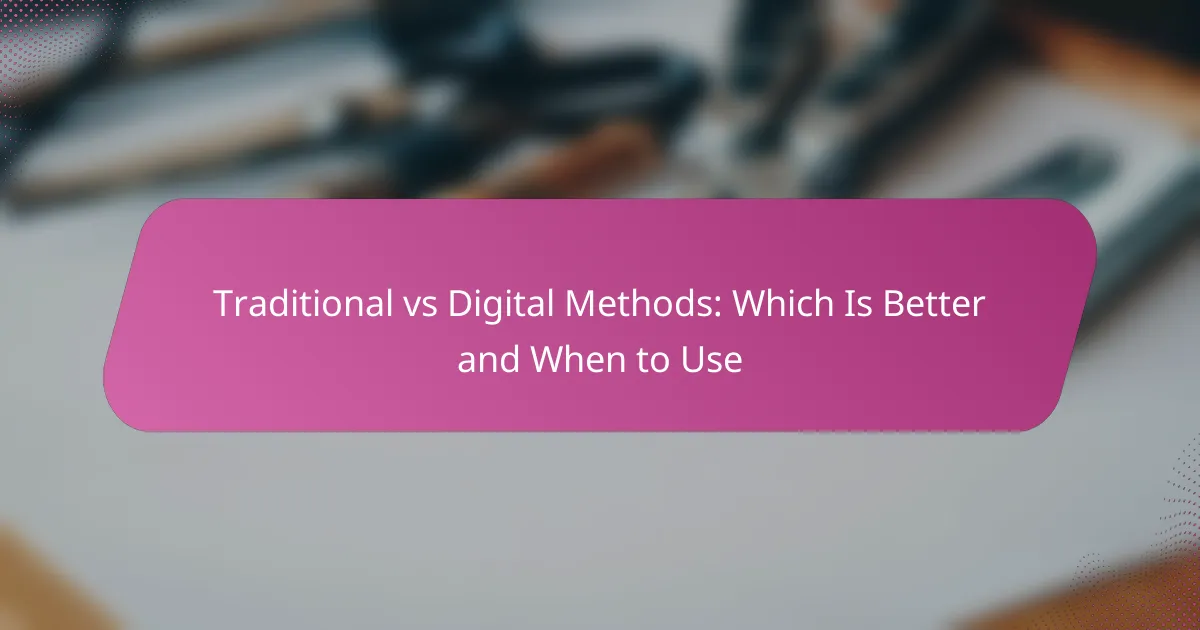In today’s marketing landscape, businesses face the challenge of choosing between traditional and digital methods, each offering unique advantages. Traditional marketing excels in building trust and personal connections within local communities, while digital marketing provides cost-effective solutions with the ability to reach a global audience and track performance in real-time. Understanding when to leverage each approach is crucial for effectively engaging target demographics and maximizing marketing efforts.

What are the advantages of traditional marketing methods?
Traditional marketing methods offer several advantages, including established credibility and a personal touch with local audiences. These approaches can effectively build trust and foster relationships, especially in community-focused markets.
Established credibility
Traditional marketing methods, such as print advertising and direct mail, have been used for decades, which contributes to their credibility. Many consumers still trust these formats more than digital ads, as they perceive them as more genuine and less intrusive.
For instance, a well-designed brochure or a local newspaper ad can enhance a brand’s reputation. Businesses should consider using traditional methods to reinforce their brand image, especially in industries where trust is paramount, like healthcare or finance.
Personal touch with local audiences
Traditional marketing allows businesses to connect personally with local audiences, fostering a sense of community. Methods such as local events, sponsorships, and face-to-face interactions create opportunities for meaningful engagement.
For example, sponsoring a local sports team or hosting a community event can strengthen ties with potential customers. Businesses should leverage these opportunities to build relationships and enhance customer loyalty, particularly in smaller towns or neighborhoods where personal connections matter significantly.

What are the advantages of digital marketing methods?
Digital marketing methods offer numerous advantages, including cost-effectiveness and the ability to reach a global audience. These methods enable businesses to target specific demographics and track performance in real-time, making them highly efficient compared to traditional marketing approaches.
Wider reach and targeting
Digital marketing allows businesses to reach a broader audience than traditional methods. With online platforms, companies can target specific demographics based on interests, behaviors, and geographic locations, ensuring that marketing efforts are directed toward the most relevant consumers.
For example, social media advertising can be tailored to specific age groups or interests, allowing brands to connect with potential customers more effectively. This targeted approach often results in higher engagement rates and better conversion outcomes.
Real-time analytics and adjustments
One of the key benefits of digital marketing is the ability to access real-time analytics. Businesses can monitor campaign performance instantly, allowing them to make data-driven decisions quickly. This flexibility enables marketers to adjust strategies on the fly, optimizing campaigns for better results.
For instance, if an email campaign is underperforming, marketers can tweak subject lines or content based on immediate feedback. This capability contrasts sharply with traditional marketing, where adjustments can take significant time and resources, often leading to missed opportunities.

When should businesses use traditional marketing?
Businesses should consider traditional marketing when targeting specific demographics or engaging with local communities. This approach can be particularly effective for reaching audiences who may not be as active online or who prefer in-person interactions.
Targeting older demographics
Traditional marketing methods, such as print ads, direct mail, and television commercials, often resonate better with older demographics. Many individuals in this age group may have limited digital engagement, making physical advertisements more impactful.
When designing campaigns for older audiences, consider using clear, large fonts and straightforward messaging. For instance, a local newspaper ad or a flyer distributed in community centers can effectively capture their attention.
Local community engagement
Traditional marketing excels in fostering local community engagement through events, sponsorships, and local media. Businesses can build strong relationships by participating in community fairs or sponsoring local sports teams, which creates a sense of trust and loyalty.
Utilizing local radio stations or newspapers for advertising can also enhance visibility within the community. Ensure that your messaging reflects local culture and values to resonate more deeply with residents.

When should businesses use digital marketing?
Businesses should use digital marketing when they aim to reach a broad audience efficiently and cost-effectively. Digital channels allow for targeted campaigns that can adapt quickly to market changes and consumer behavior.
Global audience targeting
Digital marketing enables businesses to target a global audience with relative ease. Through platforms like social media, search engines, and email, companies can reach potential customers across different countries and demographics.
To effectively target a global audience, businesses should consider localizing their content, including language and cultural references. This ensures that marketing messages resonate with diverse groups, enhancing engagement and conversion rates.
Cost-effective campaigns
Digital marketing campaigns often prove more cost-effective compared to traditional methods like print or television advertising. With options such as pay-per-click (PPC) advertising and social media promotions, businesses can set budgets that align with their financial capabilities.
For instance, small businesses can start with modest budgets, spending as little as $5 to $10 per day on social media ads. This flexibility allows for experimentation and optimization without significant financial risk.

How do traditional and digital marketing methods compare in effectiveness?
Traditional marketing methods, such as print ads and TV commercials, often reach a broad audience but can lack precise targeting. In contrast, digital marketing offers advanced targeting capabilities and measurable results, making it generally more effective for specific campaigns.
ROI analysis
Return on investment (ROI) is a critical metric for evaluating marketing effectiveness. Traditional methods may have higher upfront costs with less measurable outcomes, while digital marketing typically allows for lower costs and clearer tracking of conversions and sales. For example, businesses might see ROI from digital campaigns ranging from 200% to 400%, depending on the strategy used.
When analyzing ROI, consider the lifetime value of customers acquired through each method. Digital channels often foster ongoing engagement, leading to repeat business, while traditional methods may generate one-time sales. Balancing both approaches can enhance overall ROI.
Engagement metrics
Engagement metrics are vital for assessing how well marketing efforts resonate with the audience. Digital marketing excels in this area, providing real-time data on clicks, shares, and comments, which can inform future strategies. Traditional marketing, however, relies more on indirect measures like brand recall and surveys.
For effective engagement, businesses should focus on metrics such as click-through rates (CTR) for digital campaigns, which can range from 1% to 5%, and customer feedback for traditional methods. Understanding which metrics matter most for your goals will help optimize your marketing mix.

What factors influence the choice between traditional and digital marketing?
The choice between traditional and digital marketing is influenced by various factors including target audience demographics and budget constraints. Understanding these elements helps businesses determine the most effective marketing strategy for their specific needs.
Target audience demographics
Target audience demographics play a crucial role in deciding between traditional and digital marketing. For instance, younger audiences tend to engage more with digital platforms, while older demographics may respond better to traditional media like print or television.
Consider the preferences and behaviors of your audience. If your target market is primarily composed of millennials and Gen Z, digital marketing strategies such as social media campaigns or email marketing may yield better results. Conversely, if your audience includes older adults, traditional methods like direct mail or radio ads might be more effective.
Budget constraints
Budget constraints significantly affect the choice of marketing methods. Digital marketing often requires a lower initial investment compared to traditional marketing, which can involve substantial costs for print materials or television spots.
When allocating your marketing budget, consider the potential return on investment (ROI) for each method. Digital marketing allows for more precise tracking of performance and can be adjusted in real-time, making it a flexible option for businesses with limited funds. Traditional marketing, while potentially more expensive, can still be effective for building brand recognition in certain markets.

What are the emerging trends in marketing methods?
Emerging trends in marketing methods focus on the integration of technology and innovative strategies to enhance customer engagement and drive conversions. Businesses are increasingly adopting digital methods, while also exploring traditional approaches to create a well-rounded marketing strategy.
Integration of AI in digital marketing
The integration of AI in digital marketing is transforming how businesses interact with customers. AI tools can analyze vast amounts of data to personalize marketing campaigns, optimize ad placements, and predict consumer behavior. For instance, chatbots powered by AI can provide instant customer support, improving user experience and engagement.
When implementing AI, consider the balance between automation and human touch. While AI can handle repetitive tasks efficiently, maintaining personal connections with customers is crucial. Businesses should regularly assess the effectiveness of AI tools and adjust strategies based on performance metrics.
Hybrid marketing strategies
Hybrid marketing strategies combine traditional and digital methods to maximize reach and effectiveness. This approach allows businesses to leverage the strengths of both worlds, such as using social media for brand awareness while maintaining direct mail campaigns for local outreach. For example, a company might run a digital ad campaign alongside a print flyer distribution to target different customer segments.
To implement a hybrid strategy, start by identifying your target audience and their preferred channels. Allocate resources wisely between digital and traditional methods, ensuring that each complements the other. Regularly review the performance of both strategies to optimize your marketing efforts and adjust as needed.

How can businesses effectively combine traditional and digital marketing?
Businesses can effectively combine traditional and digital marketing by creating integrated campaigns that leverage the strengths of both methods. This approach allows for broader reach and enhanced engagement, ensuring that marketing efforts resonate across multiple platforms.
Cross-channel campaigns
Cross-channel campaigns utilize both traditional and digital marketing strategies to create a cohesive brand message. For instance, a business might run a print ad in a local magazine while simultaneously promoting the same offer on social media. This dual approach can enhance visibility and reinforce the message.
When designing cross-channel campaigns, consider the target audience’s preferences and behaviors. Use data analytics to identify which channels are most effective for reaching your audience. For example, younger demographics may respond better to digital ads, while older consumers might engage more with traditional media.
To maximize effectiveness, ensure that messaging is consistent across all channels. This includes using similar visuals, tone, and calls to action. Regularly review campaign performance to adjust strategies as needed, ensuring that both traditional and digital efforts complement each other effectively.



